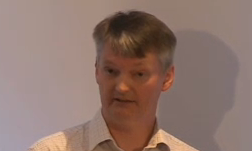Group: Patients and general interest
Description:
Video Interview with long-term ABPA patient who coughed up large sputum plugs. This patient had several episodes of pneumonia and developed bronchiectasis after diagnosis for a collapsed left lung. She was treated with inhaled corticosteroids and bronchodilators and progressed well. She was later diagnosed with possible ABPA (aspergillus precipitins were negative), after producing a large sputum plug which was positive for aspergillus hyphae. Her main symptoms were severe coughing with production of clear sputum. In December 04 her coughing became very severe and she coughed badly for 7 months. Her treatment was modified to include itraconazole (400mg/day solution- she required a higher dose than normal as she was taking other medication which reduced it’s absorption). 8 weeks later she started very severe bouts of coughing over 3 days – which produced a large number of small mucous plugs, finally a very large plug (resembling a piece of grey chewing gum) was coughed up. After this, the coughing subsided and the patient felt well and a chest X-ray at this time showed a significant improvement with clearing of shadows from the right lower lobe. Itraconazole levels have been reduced to 300mg per day and steroid intake reduced. The patient remained well in July 2007. We thank the patient for kindly providing this interview.
Medical and Patient education videos
-
Title
Description
-

Opening of the UK’s first National Centre for Aspergillosis was marked by a series of short talks from Doctors, Scientists and Patients.
-

This patient had severe kyphoscoliosis as a child with insertion of spinal rods in early adulthood. She is a life-long non-smoker. She first presented in 2001 with an irritating cough and several treatments with antibiotics failed to alleviate it.Aspergillus precipitin titre was high and she was initially diagnosed with chronic pulmonary aspergillosis with one cavity containing an aspergilloma. This patient developed resistance to all azole therapies.
-

Sources of aspergillus and how can I clean up at home? By Professor Malcolm Richardson
-

Informal recording of a meeting for patients. By Philip Langridge Aspergillosis Specialist Physiotherapist.
-

Simple steps for patients to loosen phlegm in the lungs and easily produce sputum samples for testing in the clinic. Designed for aspergillosis patients or any patients with respiratory illnesses.
-

A double lung transplant has been carried out on a young cystic fibrosis patient, who had more than 10 aspergillomas in her lung. Clip shown on BBC North West news shows an interview with Becky and Prof Denning.
-

Short history from patient’s wife. Brief history and experiences of attending National Aspergillosis Centre
-

Immunodiffusion technique to test for serum antibodies in patients – describes how to set up a test for the presence of antibodies in serum which are specific to various fungal pathogens. The technique is used to test and measure titres of these antibodies in the serum of infected patients.
-

21-year-old medical student Jo Armstead has made a major discovery, which will help doctors better able to diagnose and treat patients with Cystic Fibrosis (CF). Jo spent hundreds of hours accessing data from 30 countries to discover that there are over 75,000 people with the genetic disorder, of whom half are over 18 years – with 50 per cent infected by the fungus, Aspergillus. Professor David Denning, Director of the NHS National Aspergillosis Centre and Professor of Infectious Diseases in Global Health at the University of Manchester explains: “The life expectancy of people with CF has been increasing, but aspergillosis has a major negative impact on many. By painstakingly crunching the numbers, Jo has helped us better understand the scale of the challenge which will lead to better diagnostics and treatment strategies.” Prof Denning and Jo were interviewed on BBC-1 Breakfast last Sunday June 29th.
-

Literary event – Manchester Literature Festival hosted at Manchester Museum to increase awareness of Aspergillosis, in October 2013. Exploring literature, music and medicine.
